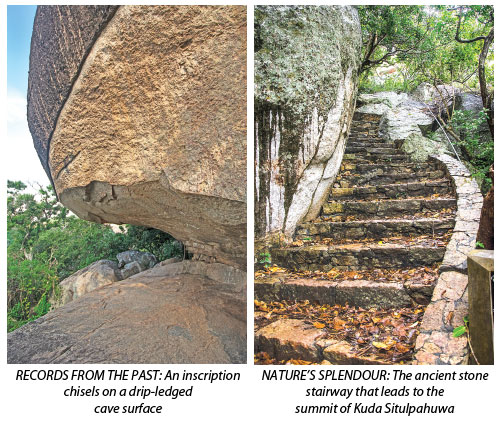
Situlpahuwa evokes a true sense of wonder in every visitor, lucky enough to visit it. We were 25 kilometres into the magnificent Ruhunu Wildlife Sanctuary at a famous archaeological site called Situlpahuwa. The site is not only famous for its 2nd Century BC Buddhist hermitage, but also for its majestic dagobas and rock carvings. What appeals most to visitors are the jungle wilderness and the panoramic view of the 1,300-square-kilometre wildlife sanctuary, which runs right down to the Indian Ocean.
 Of all the archaeological ruins, the most noteworthy archaeological artefacts are found in this large rock outcrop spread in the jungle. Situlpahuwa harbours a mass of such valuable ruins. The building of these dagobas and the rock cave hermitage are attributed to Kings Kavantissa and Dutugemunu of Magama in the Ruhuna Kingdom, in 2nd century BC. According to the ancient chronicles, Situlpahuwa in ancient times was named Cittalapabbatha which had been the hallowed abode of 12,000 Arahat bhikkus who inhabited the caves and the hillside all around.
Of all the archaeological ruins, the most noteworthy archaeological artefacts are found in this large rock outcrop spread in the jungle. Situlpahuwa harbours a mass of such valuable ruins. The building of these dagobas and the rock cave hermitage are attributed to Kings Kavantissa and Dutugemunu of Magama in the Ruhuna Kingdom, in 2nd century BC. According to the ancient chronicles, Situlpahuwa in ancient times was named Cittalapabbatha which had been the hallowed abode of 12,000 Arahat bhikkus who inhabited the caves and the hillside all around.
The Sithulpahuwa ancient hermitage is believed to be one of the few of its kind in Sri Lanka, where forest dwelling bhikkus practise of Mahayana Buddhism. Situlpahuwa gets its name from the huge rocks on which the dagobas were built. The word pawwa means a ‘big rock’ in Sinhala.
The focus of the hermitage was the great rock of Maha Situlpahuwa. Throughout the year, thousands of pilgrims come to worship at the magnificent dagoba towering over the jungle of the Ruhuna (Yala) Wildlife Sanctuary, glistening in the burning sun.
This dagoba is not as ancient as the rest of the hermitage. It had been built over the original dagoba and was reconstructed recently.On the terrace surrounding it are the remains of many stone ruined stupas and structures.
From the top of the rock mountain, visitors can see the whole of the Ruhunu Sanctuary, right down to the sea on one side and the central hills on the other. Scattered around the rocky outcrops are more than 60 inscriptions and small ruined dagobas identifying Situlpahuwa as a hermitage of celebrated piety and scholarship.
More interesting to the adventurous traveller is a little path leading out from Maha Situlpahuwa beside an ancient pond filled with crocodiles that crawl out to the banks at noon to sun bathe. Less than a kilometre away through the jungle, the path leads to a smaller dagoba called Kuda Situlpahuwa, seen atop another rocky outcrop, which is even higher than Maha Situlpahuwa.
For those whose interest extend beyond archaeology, this is the exciting part, for the path takes the visitors into the middle of the wilderness, where, save for the cacophony of jungle sounds – peace prevails. The hillside is scattered with boulders of different size and shape. Hidden among them are a number of caves with drip ledges and inscriptions of many kinds. A flight of stairs winds through the slope, weaving through the forest and curving round the hill. Trees snake their way between the rocks, creating a shaded passage to the top.
Climbing further on the uneven stairway, one would stumble upon one of the most unique features of Situlpahuwa. A few yards up, an umbrella-shaped rock forms a passage, leaning against another rock. Beneath the first are indications of the beliefs of the village folk. Stacked against the rock are hundreds of little sticks, small rock slabs and branches. The villagers break the branches and offer them to the jungle deities for protection before they venture out into the jungle.

Today, the surrounding areas of the umbrella-shaped rock are renovated, by construction of a new staircase and the erection of a Buddha statue inside the rocky boulder. Travellers have to climb a near-vertical rock face, supported by a rickety iron hand-rail and tiny footholds carved into the rock, before climbing the second rock mountain. The effort is worthwhile. The view is even better from here.
Atop the hillock, a cool breeze brushes against the cheek as we take in the charming landscape. The jagged outline of the central hills, enveloped by the white puffs of clouds, present a pretty picture against the blue canvas of the sky. Below, the gleaming pools and the rock outcrops nestling amid the green canopy are enchanting to look at.
Historians claimthe Kuda Situlpahuwa hill was once linked to the main hermitage by a paved path fringed with flowering bushes. On both sides of the path were drip-ledge caves with inscriptions and rooms built with stone and mud, where bhikkus meditated. Although these dagobas and rooms are in ruin today, the more adventurous can even now venture off the main path and find remnants of these caves and rooms.
Situlpahuwa is a tranquil spot – a confluence of history and religion. The serenity you experience in the caves and the rocky surrounding beauty is worth the arduous climb.
The temple administration is busy giving the place a facelift. Many tourists and pilgrims have begun visiting the spot to catch a glimpse of the glorious past of yore and the panoramic view of the endless green carpet of the Ruhuna (Yala) Wildlife Sanctuary. The temple authority advises that visitors return to the main hermitage before sunset. However, once the heady view envelops you, such advice may soon be disregarded.
